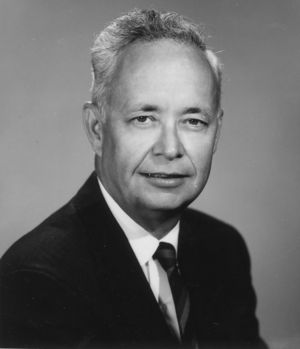Patrick E. Haggerty
- Birthdate
- 1914/03/17
- Birthplace
- Harvey, ND, USA
- Death date
- 1980/10/01
- Associated organizations
- Texas Instruments
- Fields of study
- Semiconductors
- Awards
- IEEE Founders Medal, Henry Laurence Gantt Medal
1962
Patrick E. Haggerty, IRE President, 1962, was the first general manager of the Geophysical Service Incorporated’s Laboratory and Manufacturing division. He became executive vice president and director of Texas Instruments, which was formerly Geophysical Service Incorporated.
Biography
Patrick E. Haggerty was born on 17 March 1914 at Harvey, North Dakota, son of a railroad telegrapher. He majored in electrical engineering at Marquette University, where he received the Bachelor of Science in Electrical Engineering degree in 1936.
While in school, Haggarty worked part time for the Badger Carton Company in Milwaukee, and became production manager for the company upon graduation. In 1942 he became a reserve officer in the U. S. Navy's Bureau of Aeronautics, rising to the rank of Lieutenant. During the latter war years, he was head of the Bureau's Electronics Production branch, which was responsible for the production of all airborne electronic equipment.
In November 1945, he joined Geophysical Service Incorporated (GSI) in Texas, a company which used new technologies to search for oil. As the first General Manager of the new Laboratory and Manufacturing division (L&M), Haggerty was charged with broadening and diversifying the company through manufactured products. It became clear to him that the most exciting electronic developments of the preceding 25 years were based on circuitry and the construction of electronic components. He firmly believed that the electronic developments in the succeeding quarter-century would be closely tied to the abilities to comprehend, create, manipulate, and fabricate new materials with particular emphasis on knowledge at the structure-of-matter level. His ideas and leadership helped transform the L&M division into one of the world’s leading technology developers.
In 1951, GSI changed its name to Texas Instruments, and Haggerty was promoted to Executive Vice President and Director. By 1958, Haggarty was President of the company, and became Chairman of the Board of Directors in 1966. During his tenure, Texas Instruments grew from 554 employees in 1946 to more than 38,000. Stepping down as Chairman in 1976, he remained a General Director of the company until 1980.
Texas Instruments entered the semiconductor business in 1952, pursuing Haggarty’s vision, as a licensee of transistor technology from Western Electric. By 1954 the company was introducing groundbreaking technologies, including two industry firsts: the first commercially available silicon transistors and the first germanium radio transistors. The latter of these made possible the first pocket radio and advanced the development of the semiconductor market. Haggerty led the company further into development of semiconductor networks. The first practical integrated circuit was invented in TI laboratories, evidenced by patents issued members of TI's technical staff in 1964.
Haggerty was co-chairman of the committee which effected the merger of the Institute of Radio Engineers (which he served as President in 1962) and the American Institute of Electrical Engineers which resulted in the IEEE. He was honored as a Fellow of the IEEE. In 1968, Haggerty was awarded the 1968 IEEE Founders Medal "For outstanding contributions to the leadership of the electrical and electronics engineering profession, with special reference to the development of the worldwide semiconductor industry and service to the profession through his contributions leading to the creation of the IEEE." In 1975, the ASME honored him with the Henry Laurence Gantt Medal.
Haggarty was a member of the National Academy of Engineering and the 1967 recipient of the Electronic Industries Association Medal of Honor. His capabilities and contributions were recognized with honorary degrees from Marquette University, St. Mary's University, Polytechnic Institute of Brooklyn, University of Dallas, and North Dakota State University.
His technical-managerial-industrial skills also were utilized in various advisory positions in the U. S. Government, including the Defense Science Board as Vice Chairman, and the National Commission on Technology, Automation, and Economic Progress. He also served on the President’s Commission on the Accident at Three Mile Island in 1979.
Haggerty had a leisure time passion for sailing. His sloop, Bay Bea, was second in Class C in the 1966 Transatlantic Race, first in class and third over-all in the 1966 Southern Ocean Racing Conference, and eighth over-all in the 1967 SORC. He was one of seven members of a syndicate that sponsored the Intrepid, winner of four out of four races competing with Australia's Dame Pattie in the America's Cup Races in the fall of 1967.
Further Research
IEEE Merger Collection - a collection of correspondence and records pertaining to the IEEE Merger, in which Haggerty played a significant part
Patrick Haggerty. Texas Instruments Corporate Biography.
